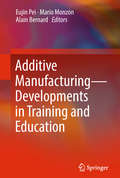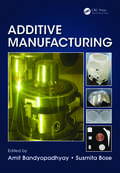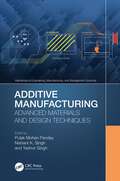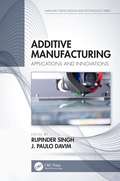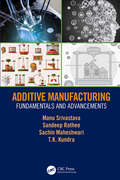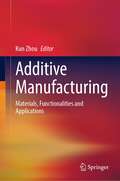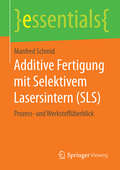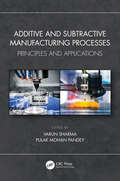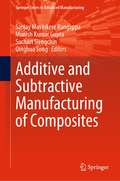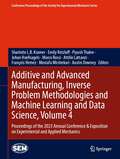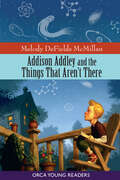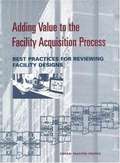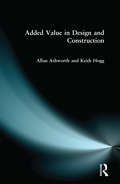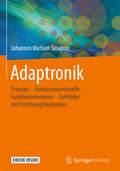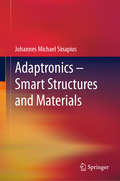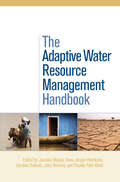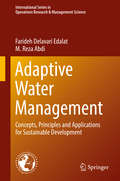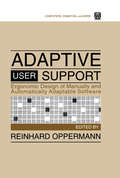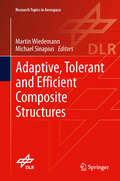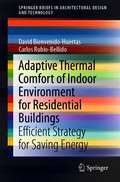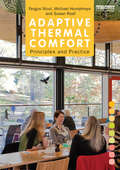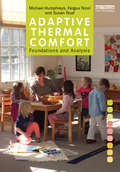- Table View
- List View
Additive Manufacturing – Developments in Training and Education
by Alain Bernard Eujin Pei Mario MonzónThis book provides an overview of training and teaching methods, as well as education strategies, for Additive Manufacturing (AM) and its application in different business sectors. It presents real-world applications and case studies to demonstrate the key practical and theoretical fundamentals of AM training, written by international experts from the field. Additive Manufacturing is a rapidly developing technology, and having a well-trained workforce is essential. Accordingly, readers are introduced to new training approaches and recent breakthroughs that can facilitate and accelerate the design, application and implementation of AM.The book’s contributors discuss many topics to provide readers a fundamental grasp of AM, including:· collaboration among educational bodies, and between industry and governments;· strategies for implementing AM training;· new teaching methods;· training programs that provide alternative employment choices;· the need for certification by professional bodies; and· promoting awareness of AM in society. This book offers an excellent source of information for researchers and industrial engineers who are interested in expanding their AM expertise, and learning how to implement it. It will also be of interest to readers who want to learn about the practicalities of adopting training and teaching for AM.
Additive Manufacturing
by Amit Bandyopadhyay Susmita BoseThe field of additive manufacturing has seen explosive growth in recent years due largely in part to renewed interest from the manufacturing sector. Conceptually, additive manufacturing, or industrial 3D printing, is a way to build parts without using any part-specific tooling or dies from the computer-aided design (CAD) file of the part. Today, mo
Additive Manufacturing: Advanced Materials and Design Techniques (Mathematical Engineering, Manufacturing, and Management Sciences)
by Pulak Mohan Pandey Nishant K. Singh Yashvir SinghThe text explores the development, use, and effect of additive manufacturing and digital manufacturing technologies for diverse applications. It will serve as an ideal reference text for graduate students and academic researchers in diverse engineering fields including industrial, manufacturing, and materials science. This book: Discusses the application of 3D virtual models to lasers, electron beams, and computer-controlled additive manufacturing machines Covers applications of additive manufacturing in diverse areas including healthcare, electronics engineering, and production engineering Explains the use of additive manufacturing for biocomposites and functionally graded materials Highlights rapid manufacturing of metallic components using 3D printing Illustrates production and optimization of dental crowns using additive manufacturing This book covers recent developments in manufacturing technology, such as additive manufacturing, 3D printing, rapid prototyping, production process operations, and manufacturing sustainability. The text further emphasizes the use of additive manufacturing for biocomposites and functionally graded materials. It will serve as an ideal reference text for graduate students and academic researchers in the fields of industrial engineering, manufacturing engineering, automotive engineering, aerospace engineering, and materials science.
Additive Manufacturing: Applications and Innovations (Manufacturing Design and Technology)
by Rupinder Singh and J. Paulo DavimThere has been a great deal of progress in additive manufacturing (AM) during the past two decades and recent developments have been highlighted by many researchers. However, until now, there has been a limit to what is available for beginners in a step-by-step format, showcasing the different commercial AM technologies for field application. This book helps fill that gap. Additive Manufacturing: Applications and Innovations presents case studies of commonly used AM technologies with basic numerical problems for better understanding. It also includes hybrid processes and 4D printing applications, which currently are not offered in other AM books. Features Offers solved and unsolved problems in additive manufacturing Provides an understanding for additive manufacturing per international standards Includes case studies for better understanding of the individual processes Presents a review of specific technology highlights Introduces future research directions, mainly in 4D printing applications
Additive Manufacturing: Fundamentals and Advancements
by Manu Srivastava Sandeep Rathee Sachin Maheshwari Tk KundraThere is a growing need for manufacturing optimization all over the world. The immense market of Additive Manufacturing (AM) technologies dictates a need for a book that will provide knowledge of the various aspects of AM for anyone interested in learning about this fast-growing topic. This book disseminates knowledge of AM amongst scholars at graduate level, post graduate level, doctoral level, as well as industry personnel. The objective is to offer a state-of-the-art book which covers all aspects of AM and incorporates all information regarding trends, historical developments, classifications, materials, tooling, software issues, dynamic design, principles, limitations, and communication interfaces in a one-stop resource. Features: Breaks down systematic coverage of various aspects of AM within four distinct sections Contains details of various AM techniques based on ASTM guidelines Discusses many AM applications with suitable illustrations Includes recent trends in the field of AM Covers engineering materials utilized as raw materials in AM Compares AM techniques with different traditional manufacturing methods
Additive Manufacturing: Materials, Functionalities and Applications
by Kun ZhouThis book focuses on the advances of additive manufacturing in the applications of wearable electronics, energy storage, biomedical implants and devices, drug delivery, and technologies for 4D printing, large-scale printing, and ceramics printing. It provides timely insights into the materials, functionalities, and applications of additive manufacturing.
Additive Fertigung mit Selektivem Lasersintern: Prozess- und Werkstoffüberblick (essentials)
by Manfred SchmidDieses essential stellt das Selektive Lasersintern als Verfahren der additiven Fertigung im Kontext anderer 3D-Druck-Prozesse vor. Manfred Schmid erläutert verschiedene Technologien, die zu den additiven Verfahren gezählt werden, und gibt einen Einblick in die Prozessprinzipien und Werkstoffe. Die grundlegenden Werkstoffvarianten unterschiedlicher Hersteller werden ebenso thematisiert wie die Limitationen des Verfahrens aufgrund reduzierter Bauteildichte und -anisotropie. Das anspruchsvolle Verfahren des Lasersinterns, das die Stufe vom Prototyping zur Produktion überwinden und eine ,,echte" Fertigungstechnologie werden kann, wird detailliert, aber dennoch in kompakter Form beschrieben. Ein Ausblick hinsichtlich bereits vorliegender und gewünschter alternativer Materialien rundet das essential ab.
Additive and Subtractive Manufacturing Processes: Principles and Applications
by Varun Sharma Pulak Mohan PandeyThis reference text discusses fundamentals, classification, principles, applications of additive and subtractive manufacturing processes in a single volume. The text discusses 3D printing techniques with the help of practical case studies, covers rapid tooling using microwave sintering and ultrasonic assisted sintering process, and covers different hybrid manufacturing techniques like cryo-MQL, and textured cutting inserts. It covers important topics including green manufacturing, ultrasonic assisted machining, electro thermal based non-conventional machining processes, metal based additive manufacturing, LASER based additive manufacturing, indirect rapid tooling, and polymer based additive manufacturing. The book- Discusses additive and subtractive manufacturing processes in detail. Covers hybrid manufacturing processes. Provides life cycle analysis of conventional machining. Discusses biomedical and industrial applications of additive manufacturing. The text will be useful for senior undergraduate, graduate students, and academic researchers in areas including industrial and manufacturing engineering, mechanical engineering, and production engineering. Discussing the sustainability aspects of conventional machining in reducing carbon footprint of machining by adopting different hybrid and non-conventional machining processes, this text will be useful for senior undergraduate, graduate students, and academic researchers in areas including industrial and manufacturing engineering, mechanical engineering, and production engineering.
Additive and Subtractive Manufacturing of Composites (Springer Series in Advanced Manufacturing)
by Sanjay Mavinkere Rangappa Munish Kumar Gupta Suchart Siengchin Qinghua SongThis book describes crucial aspects related to the additive and subtractive manufacturing of different composites. The first half of this book mainly deals with the various types of composite fabrication methods along with the introduction, features and mechanisms and also the processing of composite materials via additive manufacturing route. Also, the thermal, mechanical, physical and chemical properties relevant to the processing of composite materials are included in the chapters. The second half of this book primarily demonstrates an extensive section on the different types of additive manufacturing processes like selective laser sintering, selective laser melting, stereolithography, fused deposition modeling and material jetting used to fabricate the metals and polymers. Also, the chapters address the complete description of fabrication processes for metal matrix composites and polymer matrix composites. Moreover, the different methods adopted such as short peening, micro-machining, heat-treatment and solution treatment to improve the surface improvement are well discussed. This book gives many helps to researchers and students in the fields of the additive and subtractive manufacturing of different composites.
Additive and Advanced Manufacturing, Inverse Problem Methodologies and Machine Learning and Data Science, Volume 4: Proceedings of the 2023 Annual Conference & Exposition on Experimental and Applied Mechanics (Conference Proceedings of the Society for Experimental Mechanics Series)
by Sharlotte L. B. Kramer Emily Retzlaff Piyush Thakre Johan Hoefnagels Marco Rossi Attilio Lattanzi François Hemez Mostafa Mirshekari Austin DowneyAdditive and Advanced Manufacturing, Inverse Problem Methodologies and Machine Learning and Data Science, Volume 4 of the Proceedings of the 2023 SEM Annual Conference & Exposition on Experimental and Applied Mechanics, the fourth volume of five from the Conference, brings together contributions to this important area of research and engineering. The collection presents early findings and case studies on a wide range of topics and includes papers in the following general technical research areas: AM Composites and Polymers Dynamic Behavior of Additively Manufactured Materials and Structures Joint Residual Stress and Additive Manufacturing ML for Material Model Identification Novel AM Structures Novel Processing and Testing of Additively Manufactured Materials Plasticity and Complex Material Behavior Virtual Fields Method
Addison Addley and the Things That Aren't There (Orca Young Readers)
by Melody DeFields McMillanAddison Addley hates math. He hates public speaking too. Actually, he hates anything that involves work, but he only has a couple of weeks to write and memorize his grade five speech. The problem is, he can't think of a single topic. When he finally comes up with an excellent idea for a speech, it almost writes itself, but it's his poor math skills that make speech day unforgettable.
Adding Value to the Facility Acquisition Process: BEST PRACTICES FOR REVIEWING FACILITY DESIGNS
by Ralph S. SpillingerReport on Adding Value to the Facility Acquisition Process.
Addie and Bea Make Adobe
by Amy TaoAddie and Bea use the perfect material to build a house in the desert—adobe!
Added Value in Design and Construction
by Allan Ashworth Keith HoggAdded Value in Design and Construction takes a holistic, student-centred approach to offering public and private sector clients the ultimate reward; doing more for less. The Latham Report was a call to action and this book provides students of construction with the theoretical and practical knowledge to deliver the recommendations of the report. It describes the principles and techniques crucial to adding value and reducing costs in design and construction in the twenty first century. This book examines in detail a wide range of strategies that can be applied during the design and construction process to add value and bring the best interests of the client sharply into focus.
Ada's Amazing Ideas
by Liz HuyckAda wants to win a prize one day for her inventions. She has many ideas. When it’s time to clean up her blocks, Ada has a great idea to make clean-up time easier. Ada thinks to use her father’s old socks to invent a way to stay on her two feet on an icy day! Ada’s ideas to recycle old things makes her a great inventor!
Adaptronik: Prinzipe - Funktionswerkstoffe - Funktionselemente - Zielfelder mit Forschungsbeispielen
by Johannes Michael SinapiusSeit den achtziger Jahren forschen Wissenschaftler an adaptiven Strukturen für Materialien, für multifunktionale Elemente oder sogar für vollständige Systeme. Dabei ist die Adaptronik (englisch: smart materials, smart structures, smart systems) ein Fachgebiet von ausgeprägter Interdisziplinarität. Das Buch bietet daher eine interdisziplinäre Betrachtung von adaptronischen Systemen, Werkstoffen und Funktionselementen und ihren Anwendungen. Der Lehrstoff integriert verschiedene ingenieurwissenschaftliche Disziplinen, von Elektro- und Informationstechnik über Fertigungs- und Regelungstechnik bis zu Werkstofftechnik und Strukturmechanik – um nur einige der relevanten Fachgebiete zu nennen. Ausgehend von den grundlegenden Prinzipien und Varianten adaptronischer Systeme und Funktionswerkstoffe werden in dem Lehrbuch die unterschiedlichen Bauweisen von Funktionselementen erläutert. Darauf aufbauend lernen Leser, wie diese Kenntnisse auf die aktive Formkontrolle, die aktive Vibrationskontrolle und die aktive Vibroakustik anzuwenden sind. Für jedes dieser Themenfelder stellt der Autor aktuelle Beispiele aus der Forschung vor, diskutiert Forschungsergebnisse und zukünftige Forschungsfragen. Jedes der neun Kapitel schließt mit Hinweisen auf weiterführende Literatur. Ein Verzeichnis der verwendeten mathematischen Symbole und ein Stichwortverzeichnis erleichtern Lesern das Lernen.Das Buch wendet sich an Masterstudierende in ingenieurwissenschaftlichen Studiengängen wie Maschinenbau, Luft- und Raumfahrttechnik, Mechatronik, Kraftfahrzeugtechnik sowie verwandte Studiengänge. Praktikern in der Industrie, die sich in das Gebiet der Adaptronik einarbeiten wollen, bietet das Buch einen umfassenden Überblick und es dient zugleich ein zuverlässiges Nachschlagewerk.
Adaptronics – Smart Structures and Materials
by Johannes Michael SinapiusSince the 1980s, scientists have been researching adaptive structures for materials, for multifunctional elements or even for complete systems. Adaptronics (smart materials, smart structures, smart systems) is a field of distinct interdisciplinarity. The book therefore offers an interdisciplinary view of adaptronic systems, materials and functional elements and their applications. The subject matter integrates various engineering disciplines, from electrical engineering and information technology to manufacturing and control engineering, materials engineering and structural mechanics - to name but a few of the relevant subject areas. Starting from the basic principles and variants of adaptronic systems and functional materials, the textbook explains the different construction methods of functional elements. Building on this, readers learn how to apply this knowledge to active shape control, active vibration control and active vibroacoustics. For each of these topics the author presents current examples from research, discusses research results and future research questions. Each of the nine chapters closes with references to further literature. An index of the mathematical symbols used and a keyword index facilitate learning for readers.The book is aimed at Master's students in engineering courses such as mechanical engineering, aerospace engineering, mechatronics, automotive engineering and related courses. The book provides a comprehensive overview for industrial practitioners who want to familiarize themselves with the field of adaptronics and also serves as a reliable reference book.
Adaptive Wireless Communications
by Daniel W. Bliss Siddhartan GovindasamyAdopting a balanced mix of theory, algorithms and practical design issues, this comprehensive volume explores cutting-edge applications in adaptive wireless communications and the implications these techniques have for future wireless network performance. Presenting practical concerns in the context of different strands from information theory, parameter estimation theory, array processing and wireless communication, the authors present a complete picture of the field. Topics covered include advanced multiple-antenna adaptive processing, ad hoc networking, MIMO, MAC protocols, space-time coding, cellular networks and cognitive radio, with the significance and effects of both internal and external interference a recurrent theme throughout. A broad, self-contained technical introduction to all the necessary mathematics, statistics, estimation theory and information theory is included, and topics are accompanied by a range of engaging end-of-chapter problems. With solutions available online, this is the perfect self-study resource for students of advanced wireless systems and wireless industry professionals.
The Adaptive Water Resource Management Handbook
by Claudia Pahl-Wostl Jaroslav Mysiak Caroline Sullivan John Bromley Hans Jørgen HenriksonThe complexity of current water resource management poses many challenges. Water managers need to solve a range of interrelated water dilemmas, such as balancing water quantity and quality, flooding, drought, maintaining biodiversity and ecological functions and services, in a context where human beliefs, actions and values play a central role. Furthermore, the growing uncertainties of global climate change and the long term implications of management actions make the problems even more difficult. This book explains the benefits, outcomes and lessons learned from adaptive water management (AWM). In essence AWM is a way of responding to uncertainty by designing policy measures which are provisional and incremental, subject to subsequent modification in response to environmental change and other variables. Included are illustrative case studies from seven river basins from across Europe, West Asia and Africa: the Elbe, Rhine, Guadiana, Tisza, Orange, Nile and Amudarya. These exemplify the key challenges of adaptive water management, especially when rivers cross national boundaries, creating additional problems of governance.
Adaptive Water Management: Concepts, Principles and Applications for Sustainable Development (International Series in Operations Research & Management Science #258)
by Farideh Delavari Edalat M. Reza AbdiThis book explores a new framework of Adaptive Water Management (AWM) for evaluating existing approaches in urban water management. It highlights the need to adopt multidisciplinary strategies in water management while providing an in-depth understanding of institutional interactions amongst different water related sectors. The key characteristics of AWM i. e. polycentric governance, organisational flexibility and public participation are investigated and described through a critical review of the relevant literature. The book presents an empirical case study undertaken in a selected developing-country city to investigate the potential gaps between the current water management approaches and possible implementation of AWM. Feasibility of AWM operations is examined in an environment surrounded by established water management structure with centralised governance and an institutional process based on technical flexibility. The key elements of AWM performance are (re)structured and transformed into decision support systems. Multi criteria decision models are developed to facilitate quantification and visualization of the elements derived from the case study, which is involved with water companies and water consumers. The book describes how the concept of AWM, along with structuring suitable decision support systems, can be developed and applied to developing-country cities. The book highlights the barriers for applying the AWM strategies that include established centralised decision making, bureaucratic interactions with external organisations, lack of organisational flexibility within the institutions, and lack of recognition of public role in water management. The findings outline that despite the lack of adaptability in the current water management in the case study, as an example of developing countries, there are positive attitudes among water professionals and the public towards adaptability through public-institutional participation. /p>
Adaptive User Support: Ergonomic Design of Manually and Automatically Adaptable Software
by Reinhard OppermannThe potential of software applications to solve an array of office and administrative problems is increasing faster than the ability of users to exploit it. We need to make systems easier to learn and more comfortable to use. This book reports a major advance in the effort to accomplish both goals. Flexcel enables users to modify access and dialog dynamics to their specific requirements. Relying on a plan recognition feature, the system proposes adaptations or uses of adaptations. The ongoing conflict between the adaptive and the adaptable is resolved in an integration: user and system share the responsibility for the initiatives, decision-making and execution. A "critic" component of the system then analyzes the user's handling of the adaptation tools and suggests improvements. The system offers an environment in which users can explore as they learn. HyPlan implements the context-sensitive help that facilitates learning on demand. When the PLANET plan-recognition feature identifies the kinds of support for work that may possibly be required, HyPlan provides, on request, specific assistance in the form of hypermedia or animated displays and tutorials. Developmental research has shown that users take advantage of opportunities to adapt interfaces only in conjunction with help-functions -- which are accepted when they do not interrupt work. And studies by social scientists have shown that adaptations of technical systems have to be integrated into the overall process of organizational innovation and undertaken cooperatively. This book will stimulate all those concerned with software -- from computational, cognitive, ergonomic, or organizational standpoints -- to reconceive the relationship between design and user support.
Adaptive, tolerant and efficient composite structures: Adaptive, Tolerant And Efficient Composite Structures (Research Topics in Aerospace)
by Martin Wiedemann Michael SinapiusComposite structures are most efficient in performance and production cost when combined with smart materials making them adaptable to changing operational conditions. The specific production processes of composites offer the possibility to integrate more functions thus making the structure more valuable. Active functions can be realized by smart materials, e.g. morphing, active vibration control, active structure acoustic control or structure health monitoring. The foundation is a sound understanding of materials, design methods, design principles, production technologies and adaptronics. Along the complete process chain this disciplines together deliver advanced lightweight solutions for applications ranging from mechanical engineering to vehicles, airframe and finally space structures. This book provides the scientific foundations as well as inspiring new ideas for engineers working in the field of composite lightweight structures.
Adaptive Thermal Comfort of Indoor Environment for Residential Buildings: Efficient Strategy for Saving Energy (SpringerBriefs in Architectural Design and Technology)
by David Bienvenido-Huertas Carlos Rubio-BellidoThis book is structured in four parts: First, it analyzes the sustainability objectives established for the building stock and the importance of thermal comfort in this aspect. Second, the existing adaptive thermal comfort models and the main energy-saving measures associated with these models are analyzed. Third, the energy savings obtained with these measures are analyzed in several case studies, comparing the results obtained with other energy conservation measures, such as the improvement of the façade. The analysis is carried out from an energy and economic perspective. Finally, a decision‐making process based on fuzzy logic is established. As an expected result, the content of the book contributes to assist architects in designing more efficient buildings from the perspective of user behavior.
Adaptive Thermal Comfort: The Designer's Guide To Adaptive Thermal Comfort
by Susan Roaf Michael Humphreys Fergus NicolThe fundamental function of buildings is to provide safe and healthy shelter. For the fortunate they also provide comfort and delight. In the twentieth century comfort became a 'product' produced by machines and run on cheap energy. In a world where fossil fuels are becoming ever scarcer and more expensive, and the climate more extreme, the challenge of designing comfortable buildings today requires a new approach. This timely book is the first in a trilogy from leaders in the field which will provide just that. It explains, in a clear and comprehensible manner, how we stay comfortable by using our bodies, minds, buildings and their systems to adapt to indoor and outdoor conditions which change with the weather and the climate. The book is in two sections. The first introduces the principles on which the theory of adaptive thermal comfort is based. The second explains how to use field studies to measure thermal comfort in practice and to analyze the data gathered. Architects have gradually passed responsibility for building performance to service engineers who are largely trained to see comfort as the ‘product’, designed using simplistic comfort models. The result has contributed to a shift to buildings that use ever more energy. A growing international consensus now calls for low-energy buildings. This means designers must first produce robust, passive structures that provide occupants with many opportunities to make changes to suit their environmental needs. Ventilation using free, natural energy should be preferred and mechanical conditioning only used when the climate demands it. This book outlines the theory of adaptive thermal comfort that is essential to understand and inform such building designs. This book should be required reading for all students, teachers and practitioners of architecture, building engineering and management – for all who have a role in producing, and occupying, twenty-first century adaptive, low-carbon, comfortable buildings.
Adaptive Thermal Comfort: Foundations And Analysis
by Susan Roaf Michael Humphreys Fergus NicolThere has been widespread dissatisfaction with accepted models for predicting the conditions that people will find thermally comfortable in buildings. These models require knowledge about clothing and activity, but can give little guidance on how to quantify them in any future situation. This has forced designers to make assumptions about people’s future behaviour based on very little information and, as a result, encouraged static design indoor temperatures. This book is the second in a three volume set covering all aspects of Adaptive Thermal Comfort. The first part narrates the development of the adaptive approach to thermal comfort from its early beginnings in the 1960s. It discusses recent work in the field and suggests ways in which it can be developed and modelled. Such models can be used to set dynamic, interactive standards for thermal comfort which will help overcome the problems inherited from the past. The second part of the volume engages with the practical and theoretical problems encountered in field studies and in their statistical analysis, providing guidance towards their resolution, so that valid conclusions may be drawn from such studies.
